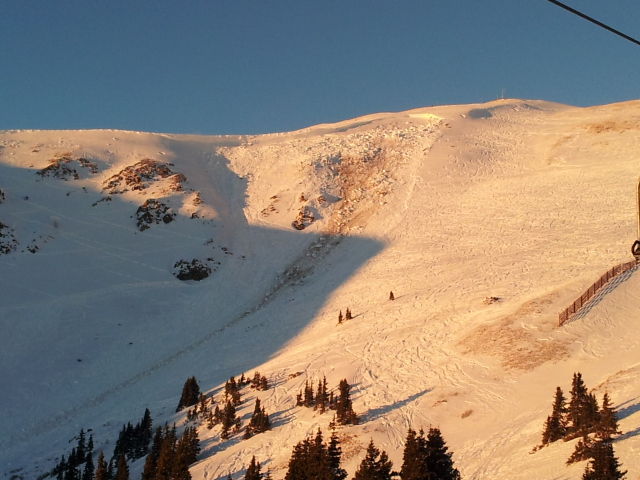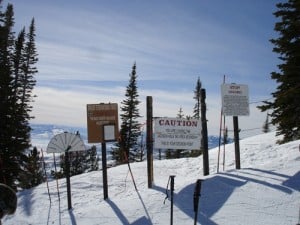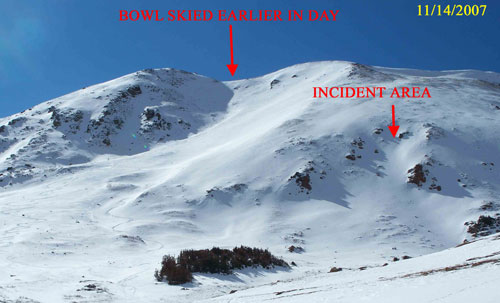News

By Jason Kornfeld, Staff Writer Posted 11 years ago March 3, 2013
Know Before You Go: Backcountry Sense
Fifteen caught, one buried, and one injured, was the final report at Arapahoe Basin Ski Resort last weekend. Although patrol had conducted avalanche mitigation, an avalanche occurred. Resort slides are rare, but this incident serves as a warning to the influx of people traveling into the backcountry.

The aftermath of the slide at Abasin two weekends ago. Photo CAIC.
In the 1980s the backcountry was a place for a select few, such as The Jackson Hole Air Force—an underground fraternity of skiers with the sole purpose of skiing the steep and the deep. This meant ducking ropes and skiing the backcountry. However, over the past decade, people of all outdoor backgrounds have started turning toward the other side of the ropes in search of their next adventure.
The backcountry offers a lot to winter enthusiasts, but at the same time, people need to be responsible, said Ethan Greene, director of the Colorado Avalanche Information Center.
“What risks people take is really their choice and that is part of the beauty of some backcountry sports. The backcountry is great because it offers a lot of recreational opportunities. But, with the freedom to do whatever you want on public lands, comes a lot of responsibility to take care of yourself.”
Dale Atkins, a Recco manager and the president of the American Avalanche Association, said a major problem is the disparity between skier ability and avalanche knowledge.
“One thing that has always been a problem is that people’s avalanche knowledge tends to lag far behind their skiing or riding ability,” Atkins said. “The old school approach was to carry rescue gear only as a back up, and travel as if you left your gear at home. Today, people use their avalanche awareness training, avalanche bulletins and rescue equipment to push the boundaries, thus, accidents become inevitable.”

Sidecountry gates. Courtesy Friends of Berthoud Pass.
This relationship between risk and recreation has become more apparent, especially with the recent tragedies at Tunnel Creek in Washington State and at Aspen earlier this season. From 1970 to 1979 there were 116 avalanche related fatalities in the United States. Over the past decade this statistic has more than doubled to 295.
A study by the SnowSports Industries America revealed a 15 percent increase in backcountry travel between the 2009/2010 and 2010/2011 seasons. Further, since 2009, backcountry gear sales have skyrocketed, demonstrated by a roughly eightfold increase in alpine A/T boot sales, 15-fold increase in splitboard sales, and 40-percent increase in skin sales.
Technology improvements have influenced the increase in backcountry travel, said Dave Byrd the director of risk and regulatory affairs at the National Ski Area Association.
“Avalanche bags, avalungs, beacons, etc., have really opened up a lot of terrain that really wasn’t as accessible 10 years ago for skiers who wanted to push the envelope,” Byrd said. “The technology has enabled people to seek and reach different parts of the mountains that they’re potentially not comfortable trying.”
As the backcountry community explodes, this creates a greater probability for encounters with avalanches. Regardless of experience, all it takes is a split-second misjudgment. This worries industry experts like Greene.
“We see the same mistakes being made by people at all different levels whether they are a novice or a professional. Often times, people try to ignore obvious signs of instability because of some other aspect. For example, using a snow pit to ignore the 40 inches of fresh snow or seeing avalanches on a northeast aspect and deciding the north aspect is safe.”

The powers of wind loading demonstrated by the largest part of the crown at Abasin two weeks ago. Courtesty CAIC.
Another problem has been our ability to recognize risk, Atkins said.
“Most of the time snow is stable or stable enough that there is not an avalanche every time someone goes out,” Atkins said. “But in the mountains there is no definitive line that should not be crossed. When we cross over it we do not necessarily know.”
Atkins said that although risk is objective and a mathematically defined value, in the mountains this changes. Making decisions in the backcountry is subjective and often means making estimates about estimates of dangers and consequences. Combined with the seduction of powder and steep lines, conservative choices become more difficult.
“When you go into the backcountry your two biggest enemies are uncertainty and yourself,” Atkins said. “When it comes to uncertainty, it’s important to address what you do not know, because when you’re dealing with predictions, you need to be able to check your emotions and dial it back.”

An avalanche occurred here in 2007. This shows the importance of knowledge and successfully evaluating risk. Courtesty CAIC.
Fortunately, there are many educational opportunities and basic steps people can take to increase safety in the backcountry.
“We have seen a huge increase in free avalanche and backcountry classes offered by resorts,” Byrd said. “Also, a lot of resorts have concession outfitter guides that are great for the less experienced, a person can take an AIRE Level I class, or, even better, do both.”
Resorts such as Jackson Hole, Sugar Bowl and Whistler Blackcomb, have taken the initiative to educate guests through free backcountry safety classes. For example, many of these classes teach terrain management and basic snow science.
Despite the value of an avalanche course, there is a common misconception. Some people view the completion of a course as a certification when it’s not, said Greene.
“What you get is a framework to go out and gain experience, and experience is going to be the thing that helps you learn to stay out of avalanches,” said Greene. “If you feel like you cannot make these decisions on Tuesday but then on Saturday after your class you can, then you have missed the point of the course.”
“In some ways, you are in a vulnerable position coming out of the course if you feel like you are empowered.”
Atkins said on top of carrying the basic gear, a transceiver, shovel, probe and Recco reflectors, when going into the backcountry, pack as if you will have to spend the night. This means extra layers, food, water, first aid, a headlamp, and have a friend who will contact authorities if necessary. Moreover, just having the right gear is not enough; it’s equally important to know how to effectively and efficiently use the necessary gear. However, this should never be used as an excuse, but instead as a contingency.
With the right training, planning and mindset, the backcountry can be enjoyed daily, even on days with higher avalanche danger.
“The backcountry is where the goods are and the great fun can be had,” Atkins said. “But, learning about snow and avalanches is a journey, and just because you got away with it last weekend does not mean you will get away with it today. Being conservative in the mountains is a good thing because the goal at the end of the day is to be able to do it again tomorrow.”
http://vimeo.com/17419230?amp;height=495&width=880 (RECCO Education Video)
http://www.sugarbowl.com/backcountry
http://avalanche.state.co.us/index.php
http://utahavalanchecenter.org/
http://www.whistlerblackcomb.com/the-mountain/backcountry/backcountry-clinics.aspx
About The Author





